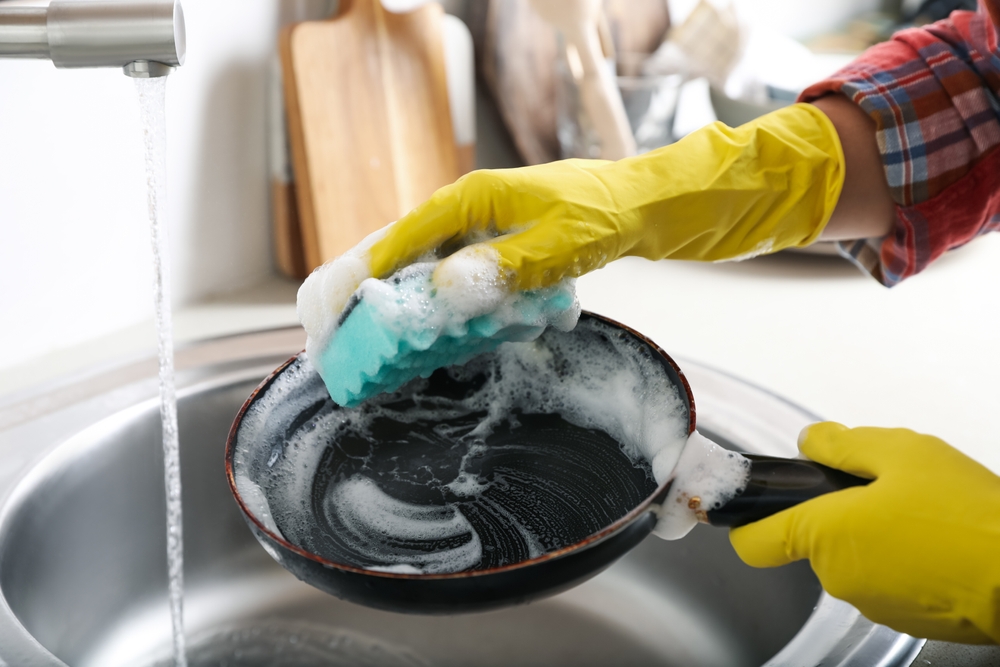In the world of culinary convenience, nonstick pans reign supreme. These kitchen marvels promise effortless cooking and cleanup, but only if you treat them right. Whether you’re a seasoned chef or a cooking novice, knowing how to properly clean and maintain your nonstick pans is crucial for their longevity and performance. In this guide, we’ll delve into the art of nonstick pan care, ensuring your favorite cookware stays in prime condition for years to come.
Understanding Nonstick Pans
Before we dive into cleaning techniques, let’s explore what makes nonstick pans so special. Nonstick cookware typically features a coating that prevents food from adhering to the surface. The two most common types are:
- PTFE (Polytetrafluoroethylene): Often known by the brand name Teflon, this coating is durable and highly effective.
- Ceramic: A newer alternative, ceramic coatings are often touted for their eco-friendliness.
These coatings work by creating a smooth, low-friction surface that food can’t grip. However, this same property that makes them so convenient also requires special care to maintain.
The Dos and Don’ts of Nonstick Pan Care
To keep your nonstick pans in top shape, follow these essential dos and don’ts:
Do:
- Use gentle cleaning methods
- Clean after each use
- Allow pans to cool before cleaning
Don’t:
- Use abrasive materials or harsh chemicals
- Submerge hot pans in cold water
- Stack pans without protection
Step-by-Step Guide to Cleaning Nonstick Pans
Immediate After-Use Care
- Allow the pan to cool completely. Sudden temperature changes can warp the pan and damage the nonstick coating.
- Wipe the cooled pan with a paper towel to remove any loose food particles or grease.
Basic Cleaning Method
- Fill your sink with warm water and add a small amount of mild dish soap.
- Submerge the pan and use a soft sponge or cloth to gently clean the surface.
- Pay special attention to any areas with stuck-on food, but avoid scrubbing aggressively.
- Rinse thoroughly with clean water to remove all soap residue.
Dealing with Stubborn Residue
For those times when gentle cleaning isn’t enough, try these methods:
- Create a paste using baking soda and water.
- Apply the paste to problem areas and let it sit for 15-20 minutes.
- Use a soft sponge to gently work the paste in circular motions.
- Rinse thoroughly and repeat if necessary.
Special Cleaning Situations
Removing Burnt-on Food
- Fill the pan with water and add 1/4 cup of baking soda.
- Bring the mixture to a gentle simmer for 15 minutes.
- Allow to cool, then wash with warm, soapy water.
Addressing Discoloration
- Create a solution of equal parts water and white vinegar.
- Bring the solution to a boil in the discolored pan.
- Remove from heat, let cool, and wash normally.
Tackling Grease Buildup
- Mix warm water with a grease-cutting dish soap.
- Soak the pan for 30 minutes to an hour.
- Wash gently with a soft sponge and rinse thoroughly.
Drying and Storing Nonstick Pans
Proper storage is key to maintaining your nonstick pans:
- Dry pans completely with a soft cloth or paper towel.
- If stacking is necessary, place a soft cloth or paper towel between each pan to prevent scratching.
- Consider using pan protectors for added safety.
Maintaining Nonstick Properties
To keep your pans performing at their best:
- Season your pan occasionally by rubbing a small amount of oil on the surface.
- Avoid using cooking sprays, which can leave a hard-to-remove residue.
- Use wooden, silicone, or plastic utensils to prevent scratching.
When to Replace Your Nonstick Pan
Even with the best care, nonstick pans don’t last forever. Look for these signs that it’s time for a replacement:
- Visible scratches or peeling on the nonstick surface
- Warping or uneven heating
- Persistent sticking, even after proper cleaning and seasoning
Most nonstick pans have a lifespan of 3-5 years with regular use. When it’s time to say goodbye, look for recycling options in your area to dispose of old pans responsibly.
Eco-Friendly Cleaning Tips
For the environmentally conscious cook:
- Use natural cleaning solutions like baking soda and vinegar.
- Opt for biodegradable dish soaps.
- Conserve water by soaking stubborn messes instead of running water continuously.
Frequently Asked Questions
Q: Can I use metal utensils on nonstick pans? A: It’s best to avoid metal utensils, as they can scratch the nonstick surface. Stick to wooden, silicone, or plastic utensils.
Q: Is it safe to put nonstick pans in the dishwasher? A: While some nonstick pans are labeled dishwasher-safe, hand washing is always gentler and recommended for prolonging the life of your cookware.
Q: How often should I season my nonstick pan? A: Seasoning frequency depends on usage, but a good rule of thumb is to season your pan every 4-6 months or when you notice food starting to stick more than usual.
Conclusion
Proper care of your nonstick pans isn’t just about cleanliness—it’s about preserving their unique properties that make cooking a joy. By following these guidelines, you’ll ensure that your favorite pans remain reliable kitchen companions for years to come. Remember, a little extra care goes a long way in maintaining the nonstick magic that makes these pans so indispensable in modern kitchens.
So, the next time you reach for your trusty nonstick pan, take a moment to appreciate its technology and give it the TLC it deserves. Your future self (and your perfectly flipped pancakes) will thank you!

